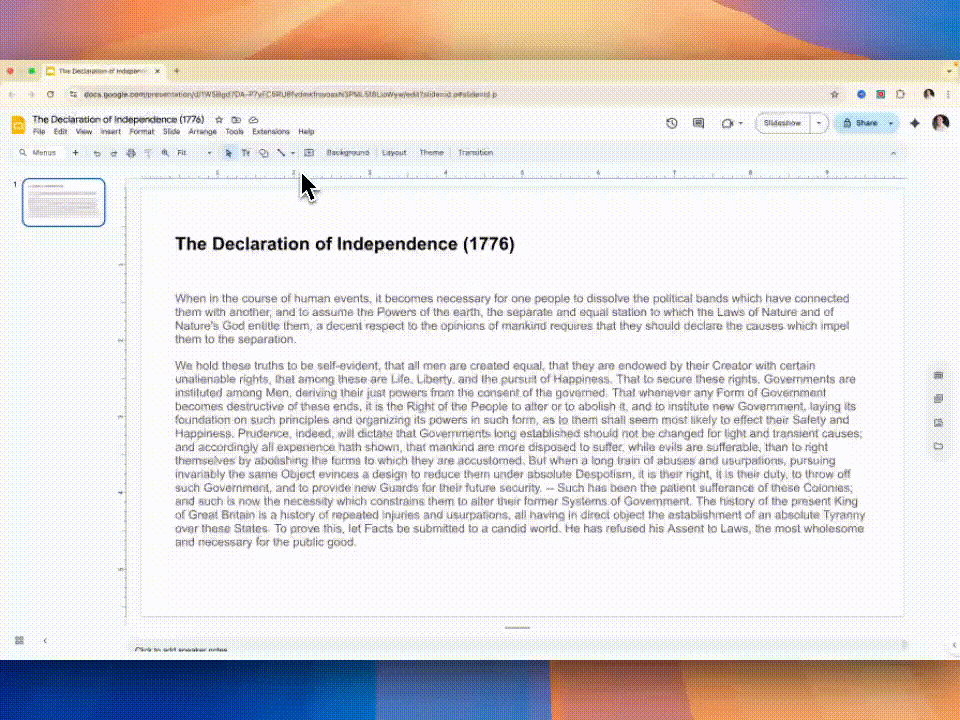If you've been searching "how to plagiarism check on Google Slides," you're not alone.
While Google Slides doesn't offer a built-in plagiarism checker, you don't need to copy your content into Docs or external websites to get the job done. With the Plagiarism Guard add-on, you can scan your presentation for plagiarism and AI-generated text directly inside Google Slides—with real-time results and instant rewriting tools.
In this article, we'll walk you through:
Let's dive in.
Even though Google Slides is used mostly for presentations, a lot of original writing lives inside your decks, especially in:
If you're quoting articles, summarizing research, or using AI tools to help draft your slides, there's a chance your content may not be fully original.
A quick scan helps you stay credible, professional, and protected—especially when you're submitting or presenting to others.
Short answer: No. Google Slides doesn't include any native plagiarism or AI detection tools.
But there's a quick workaround: use the Plagiarism Guard add-on, which integrates directly into your Slides editor. It only takes a couple of minutes to install and start scanning.
Here's the full step-by-step:
You can run the scan slide-by-slide or review speaker notes and content blocks all within the Slides editor.
Please see a demo below.

AI tools like ChatGPT and Gemini make creating content for slides fast, but speed comes with risk.
Today, more institutions, clients, and events are flagging AI-generated content in presentations. Here's why:
Even if it's not plagiarized, AI-generated text can still feel flat, repetitive, or inauthentic.
Plagiarism Guard helps by detecting AI patterns and offering instant rewrites via the Humanize feature, so your slides sound more natural and personal.
Plagiarism Guard doesn't stop at detection—it helps you fix your content too.
Select your text, click on "AI-text checker" button to see how likely it is AI-generated. Then you can click on "Humanize text" and watch it rephrase into clearer, more human language.
Keep editing — all without leaving your deck.
Scanning is smart, but starting with original content saves time and builds credibility. Here’s how to keep your slides fresh, human, and yours:
Most plagiarism tools are made for essays and Google Docs. Not this one.
Plagiarism Guard is the first tool built specifically for Google Slides.
What makes it different:
Whether you're giving a pitch, presenting research, or sharing your expertise, Plagiarism Guard helps you stay sharp and original.
Yes. While Google Slides doesn't offer native plagiarism checking, the Plagiarism Guard add-on works directly inside your Slides editor. You can highlight text, scan for plagiarism or AI-generated content, and rewrite flagged sections—all without leaving your deck.
No. Google Slides doesn't include any built-in tool for checking plagiarism or AI-generated text. To scan your presentation, you'll need a third-party add-on like Plagiarism Guard.
Yes. Plagiarism Guard runs inside your Google Workspace environment and does not send your content to external servers. Your data stays private and protected.
Absolutely. Plagiarism Guard includes a Humanize feature that rewrites AI-generated or overly formal text with one click, helping your slides sound more natural and authentic, without needing any external apps.
Google Docs doesn't have a built-in plagiarism checker, which can be problematic for students, content creators, and professionals when they work on their academic papers, essays, or other documents. This guide provides step-by-step methods for checking plagiarism using the best available tools, all within Google Docs.
Learn how to check for AI-generated text in Google Docs quickly and accurately.
Worried your college essay might get flagged by AI detectors — even if you wrote it yourself? This guide breaks down how AI detection works, what colleges actually do, and how to make sure your essay stays authentic.